As the political and environmental fallout from the Gulf of Mexico oil spill continued to worsen throughout 2010 and President Obama declared a crusade against negligent corporations, photojournalist Jack Laurenson decided to travel to Bhopal, India – home to the site of the world’s worst industrial catastrophe.
Although the Union Carbide Corporation (UCC) had long since left, he found a painful, toxic legacy and little being done to remedy the ongoing tragedy. His investigations in the UCC factory led to him being hospitalised for five days due to chemical exposure.
More than 26 years have passed since the disaster, yet thousands in Bhopal continue to suffer and die from chronic illnesses, the UCC factory is still a highly contaminated industrial graveyard and justice continues to evade the people of Bhopal.
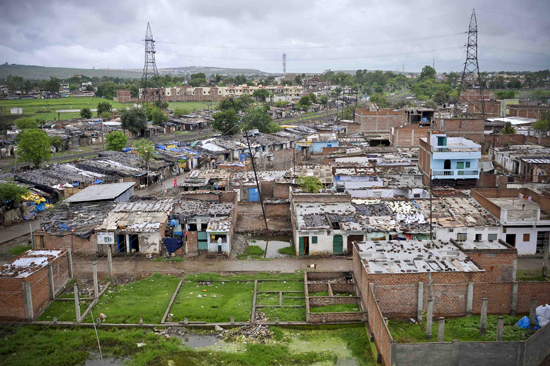 January 2011: History has shown us that we are judged and remembered by how we treat society’s most vulnerable. The people who are unfortunate enough to reside in the poorest areas of Bhopal today continue to live a life of pain and neglect in the shadow of Union Carbide’s poisonous legacy. More than 26 years on from ‘that night’ when tonnes of methyl isocyanate gas descended on Bhopal’s slums, the area surrounding the UCC compound is still labelled a ‘global toxic hot-spot’ and has been declared unfit for any kind of use. Greenpeace and the Indian Centre for Science and Environment continue to publish reports revealing an enduring environmental and humanitarian nightmare. For nearly three decades those who share collective responsibility have looked on from their ministerial offices and corporate HQs as Bhopal’s poorest citizens have constantly fought a valiant and noble fight for justice against overwhelming odds.
January 2011: History has shown us that we are judged and remembered by how we treat society’s most vulnerable. The people who are unfortunate enough to reside in the poorest areas of Bhopal today continue to live a life of pain and neglect in the shadow of Union Carbide’s poisonous legacy. More than 26 years on from ‘that night’ when tonnes of methyl isocyanate gas descended on Bhopal’s slums, the area surrounding the UCC compound is still labelled a ‘global toxic hot-spot’ and has been declared unfit for any kind of use. Greenpeace and the Indian Centre for Science and Environment continue to publish reports revealing an enduring environmental and humanitarian nightmare. For nearly three decades those who share collective responsibility have looked on from their ministerial offices and corporate HQs as Bhopal’s poorest citizens have constantly fought a valiant and noble fight for justice against overwhelming odds.
In India today, the poor are constantly left behind, all our government and the corporations do is betray us.
Gayadri is a 50-year-old woman living in a heavily gas-affected community just outside the Union Carbide facotry complex in Bhopal.
Our men are too sick to work regularly so we cannot pay taxes. That’s why they don’t help us. Everybody here feels abandoned and neglected, but that’s nothing new.
Union Carbide openly dumped its highly lethal waste in the surrounding areas for countless years, water and soil contaminated with various chemicals and heavy metals continues to claim lives and entire communities suffer with painful, debilitating illnesses. Gayadri carries on to say:
We have been asking for safe water for so long – when election time comes around and they want votes they turn up and promise such things but they never keep their word. This kind of problem, if it was happening in a rich community, would have been sorted long ago.
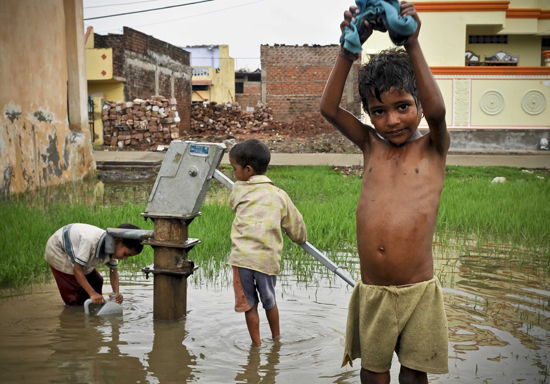 A wave of renewed focus on Bhopal and the issue of corporate liability followed the Gulf of Mexico oil spill and shortly after President Obama’s scathing public attacks on BP, his National Security Advisor, Mike Froman caused outrage when he sent what was interpreted as a veiled threat to India. He stated, in leaked emails with counterparts in New Delhi:
A wave of renewed focus on Bhopal and the issue of corporate liability followed the Gulf of Mexico oil spill and shortly after President Obama’s scathing public attacks on BP, his National Security Advisor, Mike Froman caused outrage when he sent what was interpreted as a veiled threat to India. He stated, in leaked emails with counterparts in New Delhi:
“We are hearing a lot of noise about the Dow issue – I trust that you are monitoring it carefully.” In an apparent attack on the momentum-gathering protest movement in India, he went on to say that their government should: “Avoid developments which put a chilling effect on our investment relationship.”
Survivors in Bhopal were swift to condemn the statements and said they confirmed that the US and Indian governments were far more concerned about commercial interests than real justice.
Dow’s Hall of Shame
The Dow Chemical Company – which acquired Union Carbide Corporation and all of its assets in 2001 – stubbornly refuses to take any responsibility for ongoing social and ecological damage in Bhopal. They argue that taking over UCC, should not leave them with inherited responsibilities and liabilities, despite obtaining all their wealth. The corporation – who also share responsibility for the horrific legacies left by the deadly weapons of mass destruction, Agent Orange and Napalm – are now facing renewed lawsuits in the Indian and US courts as the Government of India and activists attempt to get them to foot the bill for a final and conclusive clean-up.
A huge, toxic mess
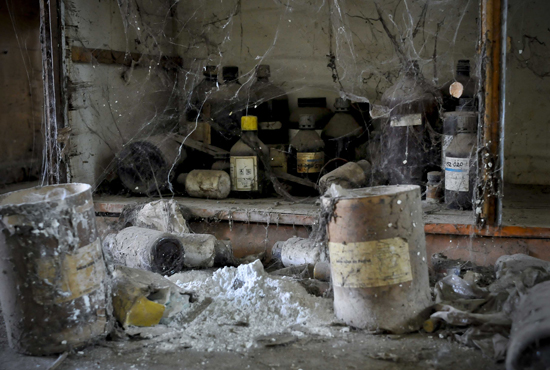 Upon discovering large deposits of abandoned chemical waste within the open UCC complex, this reporter was hospitalised for five days after suffering severe respiratory failure. Jars and sacks containing carbon tetra-chloride, chloroform, benzene, ethylyn-glykol, methanol and other highly toxic substances lay abandoned merely yards away – and often downwind – from where children gather water and graze their animals. The toxins littering the decaying factory are potentially lethal even after short-term exposure. Most are highly carcinogenic and affect the immune, respiratory and central nervous systems – some even taste and smell sweet. Greenpeace and other organisations have found terrifyingly high concentrations of these chemicals, and metals such as zinc and mercury in the local water and soil. An expensive clean-up effort has taken place in recent years but despite literally tonnes of the stuff being locked up in warehouses or dumped in other states, huge quantities of dangerous contaminants remain.
Upon discovering large deposits of abandoned chemical waste within the open UCC complex, this reporter was hospitalised for five days after suffering severe respiratory failure. Jars and sacks containing carbon tetra-chloride, chloroform, benzene, ethylyn-glykol, methanol and other highly toxic substances lay abandoned merely yards away – and often downwind – from where children gather water and graze their animals. The toxins littering the decaying factory are potentially lethal even after short-term exposure. Most are highly carcinogenic and affect the immune, respiratory and central nervous systems – some even taste and smell sweet. Greenpeace and other organisations have found terrifyingly high concentrations of these chemicals, and metals such as zinc and mercury in the local water and soil. An expensive clean-up effort has taken place in recent years but despite literally tonnes of the stuff being locked up in warehouses or dumped in other states, huge quantities of dangerous contaminants remain.
A vacuum of responsibility
Union Carbide and Dow’s failure to decontaminate what was once it’s “Indian Jewel” has created a vacuum of responsibility. Despite the evidence, many state hospitals and clinics do not acknowledge ongoing water and soil contamination and this leaves at least 40,000 chronically ill patients without access to any healthcare. Funded and supported by The Bhopal Medical Appeal, the Sambhavna Clinic and Chingari Rehabilitation Centre stand out like shining lights in the wilderness and offer entirely free treatment to the sick and dying in Bhopal who would otherwise be without hope.
A sustainable model of healthcare is needed
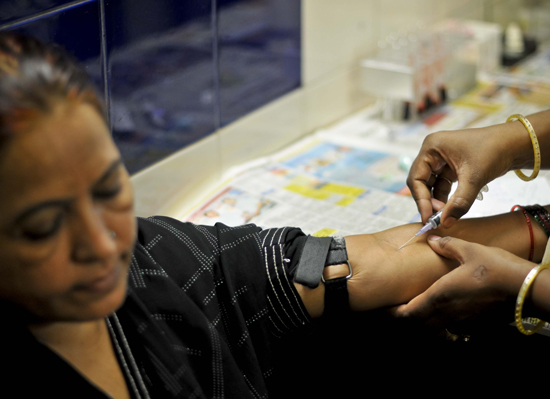 The Sambhavna Clinic opened its doors in 1995 to tackle Bhopal’s legacy of illness. Dr Sathyu Sarangi, Managing Trustee and one of the founders of the Clinic recalls:
The Sambhavna Clinic opened its doors in 1995 to tackle Bhopal’s legacy of illness. Dr Sathyu Sarangi, Managing Trustee and one of the founders of the Clinic recalls:
Treatment here was a problem, it wasn’t providing any sustained relief and in the big hospitals people were just being pumped full of huge amounts of needless, potentially dangerous drugs without any medical protocol. We were also seeing situations of significant profit arising because of huge contracts with certain pharmaceutical giants. On top of this, various studies concluded that some of the initial healthcare in Bhopal was having a hugely detrimental effect on victims of the disaster and investigations by The International Medical Convention on Bhopal found rampant abuse of steroids and psychotropic drugs. This was, and still is, a recipe for disaster.
Dr Sarangi, who arrived in Bhopal as a volunteer the day after the gas disaster in 1984 and never left, has implemented unique treatment combinations in his clinic.
By integrating traditional herbal treatment with yoga, massage and modern medicine, we are able to provide more sustained relief. On top of this, we’re not adding to the toxic load in people’s bodies by prescribing copious amounts of drugs unnecessarily.
He is also sceptical of the role The Bhopal Memorial Hospital & Research Centre (BMHRC) plays in healing Bhopal’s wounds:
The BMHRC, despite all of their funds and specialist equipment from Union Carbide, lack essential things like a gynaecology unit. Troubles with women’s menstrual cycles and other gynaecological issues are a huge problem in Bhopal and they just don’t address this issue. They also don’t acknowledge the water contamination and provide any care to those patients. This is a huge problem and the treatment at BMH often does more harm than good.
Downplaying the environmental damage
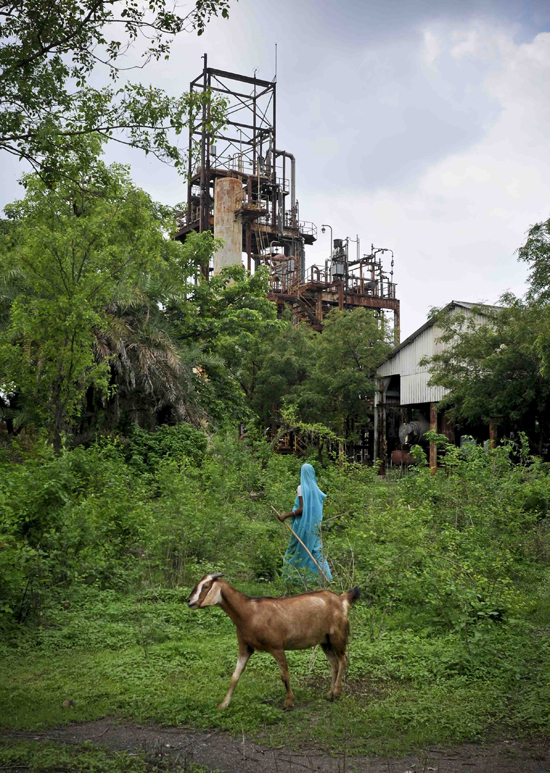 Most people are not acutely aware of the dire ecological problems that still persist near UCC – largely thanks to an irresponsible and largely effective dis-information campaign waged by the state government of Madhya Pradesh. Citizens are largely unaware that the water contains mercury concentrations millions of times higher than World Health Organisation recommended limits and they don’t know that the factory is still littered with toxic chemicals and poisonous dust, all of which cause dreadful long-term damage. Those who do know about the dangerous areas, have little choice as few suitable alternatives are available and the land continues to be a valuable yet risky resource.
Most people are not acutely aware of the dire ecological problems that still persist near UCC – largely thanks to an irresponsible and largely effective dis-information campaign waged by the state government of Madhya Pradesh. Citizens are largely unaware that the water contains mercury concentrations millions of times higher than World Health Organisation recommended limits and they don’t know that the factory is still littered with toxic chemicals and poisonous dust, all of which cause dreadful long-term damage. Those who do know about the dangerous areas, have little choice as few suitable alternatives are available and the land continues to be a valuable yet risky resource.
The Union Carbide site itself is one of the only places where people can venture to find suitable grazing ground for their livestock and plentiful groundwater for washing and cooking. People also use the highly toxic soil to build their houses. Efforts to secure the site, and stop people from using it, have been entirely useless. The large steel entrance gate is constantly open and the seven foot high walls are full of holes and in some parts entirely demolished. Government ministers and officials have also visited communities and told people – despite the overwhelming scientific evidence and the overflowing clinics – that everything is fine and that a few monsoon rains have washed away decades of dumped contaminants. Such events are frequent and have attracted huge criticism. One survivor – now a doctor explains:
Ever since 1984, the state and national governments have attempted to downplay the damage of the disaster to avoid discouraging more foreign investment. The first thing the government did in Bhopal was order the army to come in with trucks and collect corpses, peoples loved ones, then dump them in the rivers and lakes to make it look like there were less casualties. Now many departments are desperately trying to downplay the environmental damage.
Wait for the truck or…
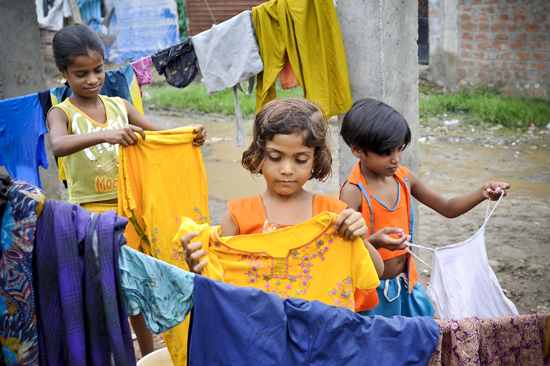 In the worst gas-affected areas, any compensation that was ever received or development that was promised is largely invisible. The slums next to Union Carbide overflow with children who have never been to school or drunk clean water. There is rampant alcoholism and unemployment because adults – who would usually be manual labourers – are too sick to work. The only evidence of any government-funded “progress” comes in the form of a giant flyover bridge which is being built directly over the communities and has resulted in dozens of homes being demolished. Then there are the water pipes and trucks delivering “fresh” drinking water to the communities. In 2005, the Supreme Court of India ruled that the State Government of Madhya Pradesh must provide clean water to its citizens. It wasn’t until 2008 that they finally started laying pipelines and arranging regular water-truck deliveries – these provisions however, are only reaching around 17 per cent of the affected communities and everybody else continues to drink water from highly poisonous sources. Water shortages in certain parts of India are becoming a huge problem, but in Bhopal – known affectionately as “the city of lakes” alternative sources could easily be made available with the right investment.
In the worst gas-affected areas, any compensation that was ever received or development that was promised is largely invisible. The slums next to Union Carbide overflow with children who have never been to school or drunk clean water. There is rampant alcoholism and unemployment because adults – who would usually be manual labourers – are too sick to work. The only evidence of any government-funded “progress” comes in the form of a giant flyover bridge which is being built directly over the communities and has resulted in dozens of homes being demolished. Then there are the water pipes and trucks delivering “fresh” drinking water to the communities. In 2005, the Supreme Court of India ruled that the State Government of Madhya Pradesh must provide clean water to its citizens. It wasn’t until 2008 that they finally started laying pipelines and arranging regular water-truck deliveries – these provisions however, are only reaching around 17 per cent of the affected communities and everybody else continues to drink water from highly poisonous sources. Water shortages in certain parts of India are becoming a huge problem, but in Bhopal – known affectionately as “the city of lakes” alternative sources could easily be made available with the right investment.
More ministerial delusions!
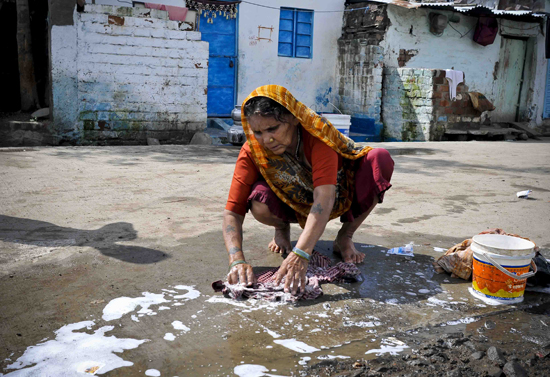 Minister Babulal Gaur is the senior minister responsible for a host of important duties in Bhopal but most notably gas relief, rehabilitation and “development.” He boasted: “I am building beautiful cities! Clean cities! Perfect cities with good roads, wonderful parks and clean water!” When asked if he thought dying of kidney failure or watching your child slowly go blind was beautiful it apparently wasn’t a subject he was keen to discuss. “We are providing perfectly clean water to all of the affected communities and there are no complaints, people are not sick, nobody has died, they have the same access to clean water as everybody else in this city!” Sadly, evidence shown to Minister Gaur that up to 80 percent of the communities still use Union Carbide’s contaminated water pumps were ignored. He insisted they were all closed. When questioned about the scarcity of government water-truck deliveries he explained that dozens of trucks visit the communities every day. Mamta, a woman who was collecting groundwater from heavily contaminated sources earlier that day said she hadn’t seen a water truck for days. Her children, with bloated tummies and painful looking skin conditions were obviously thirsty. “What can I do?” she asked. “Sometimes it makes us feverish and it gives me and my children diarrhea and vomiting but we have to drink something. We either definitely die of thirst, or we risk our lives drinking this water. It’s not much of a life, but we have no choice.”
Minister Babulal Gaur is the senior minister responsible for a host of important duties in Bhopal but most notably gas relief, rehabilitation and “development.” He boasted: “I am building beautiful cities! Clean cities! Perfect cities with good roads, wonderful parks and clean water!” When asked if he thought dying of kidney failure or watching your child slowly go blind was beautiful it apparently wasn’t a subject he was keen to discuss. “We are providing perfectly clean water to all of the affected communities and there are no complaints, people are not sick, nobody has died, they have the same access to clean water as everybody else in this city!” Sadly, evidence shown to Minister Gaur that up to 80 percent of the communities still use Union Carbide’s contaminated water pumps were ignored. He insisted they were all closed. When questioned about the scarcity of government water-truck deliveries he explained that dozens of trucks visit the communities every day. Mamta, a woman who was collecting groundwater from heavily contaminated sources earlier that day said she hadn’t seen a water truck for days. Her children, with bloated tummies and painful looking skin conditions were obviously thirsty. “What can I do?” she asked. “Sometimes it makes us feverish and it gives me and my children diarrhea and vomiting but we have to drink something. We either definitely die of thirst, or we risk our lives drinking this water. It’s not much of a life, but we have no choice.”
The frantic scramble for water suggested that this government pipe had been inactive for a while. Despite looking refreshing and pure, an old woman washing her clothes discreetly pointed out: “This water is no good, it makes us sick, it gives us ulcers and rashes on our skin, if we leave it in bottles for more than a day it’s full of bugs.” Dr Sarangi at the Sambhavna Clinic confirmed that the water supplied by the state government has tested positive for E-Coli and other harmful bacterias. He said: “The government, as usual, is being criminally negligent and mixing safe water with water sourced near an open sewer channel to save money, but these communities are full of expendable people who are too sick to work and don’t pay taxes, what do they matter?”
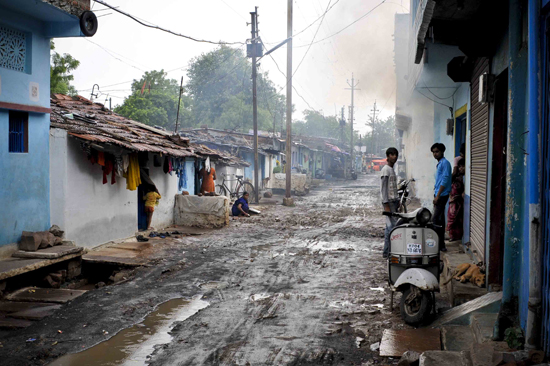 Minister Gaur prefers to blame the people for the E-Coli. “These slums are so filthy and their sanitation is so bad, they throw their waste everywhere and wonder why they get sick.” When reminded that he is the minister responsible for development and sanitation – both of which are practically non-existent outside of his small constituency of affluent New Bhopal – his argument did not explain why the water was contaminated as it left his pipeline directly from the source. He continued to alternate between denying and downplaying the problems, and eventually grew tired of the conversation and ended the interview!
Minister Gaur prefers to blame the people for the E-Coli. “These slums are so filthy and their sanitation is so bad, they throw their waste everywhere and wonder why they get sick.” When reminded that he is the minister responsible for development and sanitation – both of which are practically non-existent outside of his small constituency of affluent New Bhopal – his argument did not explain why the water was contaminated as it left his pipeline directly from the source. He continued to alternate between denying and downplaying the problems, and eventually grew tired of the conversation and ended the interview!
Institutionalised government corruption
The International Campaign for Justice in Bhopal (ICJB) blame the persistent problems here on institutionalised government corruption and Dow Chemical’s constant refusal to accept any responsibility.
Since 1984, the state government – irrespective of the political party in charge – has constantly misused and misappropriated funds meant for medical care, environmental repair and rehabilitation. In 26 years our government has received hundreds of millions of US dollars in aid from the central government and it just evaporates…
…says Sarangi, echoing similar accusations across the city.
And as far as the people of Bhopal are concerned, Dow Chemical has acquired all of Union Carbide’s equity and all of its liabilities. Union Carbide designed, supervised and operated the waste disposal process in Bhopal but has never paid out for subsequent environmental destruction. We continue to demand that Dow Chemicals accept responsibility.
In June 2010, the Indian Government approved plans for renewed financial and logistical aid to Bhopal, but activists are fearful that this money – which is estimated to be hundreds of millions of US dollars – will simply evaporate after trickling down through the same old corrupt bureaucracy in the state government. The Supreme Court of India continues to seek $US 75,000,000 in compensation from Dow Chemical to aid a conclusive clean-up of the area.
Those who continue to evade the Indian Courts and Interpol arrest warrants have not been forgotten. Leela Bi, 52, a survivor and activist whose daughter recently died from water contamination told me:
The people of Bhopal still await justice for our dead children and for Union Carbide to be held accountable in a criminal court. There have been no steps in the last 18 years to bring the American management to justice and we continue to demand Warren Anderson and his colleagues be extradited to India for culpable homicide.
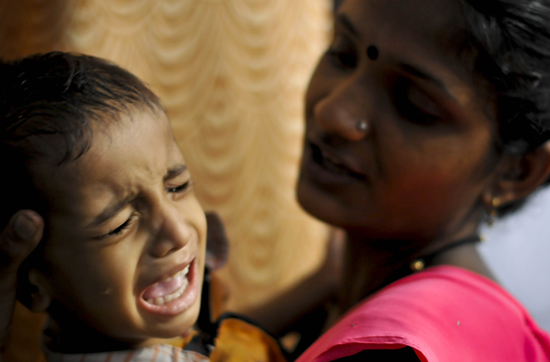 The Union Carbide Bhopal gas disaster of 1984 is the world’s worst industrial catastrophe to date, and although it has always been difficult to determine conclusive figures, at least 25,000 people are now believed to have died and 500,000 or more are still affected. Perhaps the greatest betrayal of the Indian people by the Union Carbide Corporation was not the initial disaster that brought so much chaos and suffering to the streets of this vibrant city, but the utter failure of so many to heal the toxic and painful legacy left behind.
The Union Carbide Bhopal gas disaster of 1984 is the world’s worst industrial catastrophe to date, and although it has always been difficult to determine conclusive figures, at least 25,000 people are now believed to have died and 500,000 or more are still affected. Perhaps the greatest betrayal of the Indian people by the Union Carbide Corporation was not the initial disaster that brought so much chaos and suffering to the streets of this vibrant city, but the utter failure of so many to heal the toxic and painful legacy left behind.
Despite the healing wounds, and despite the defiance and bravery of ordinary people here trying to rebuild their lives, the tragedy of Bhopal continues.
Jack Laurenson is a photojournalist and founding member of Lacuna Media, he is based out of London and works regularly in India.
Jack received extensive medical treatment at the Sambhavna Clinic in Bhopal for his exposure to chemicals in the abandoned Union Carbide factory and is recovering well.
To see the complete Bhopal photo-essay, please visit www.lacunamedia.org


